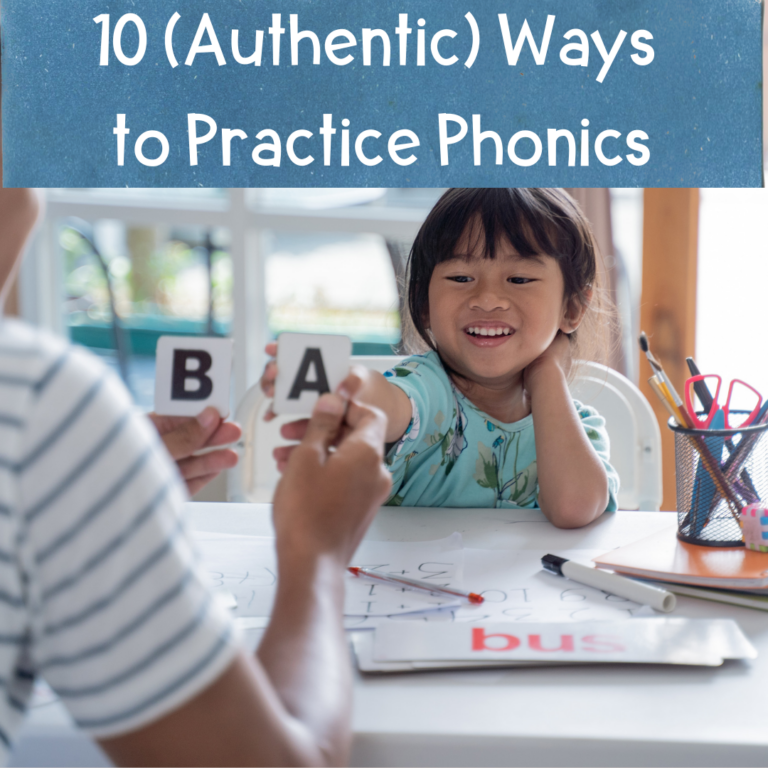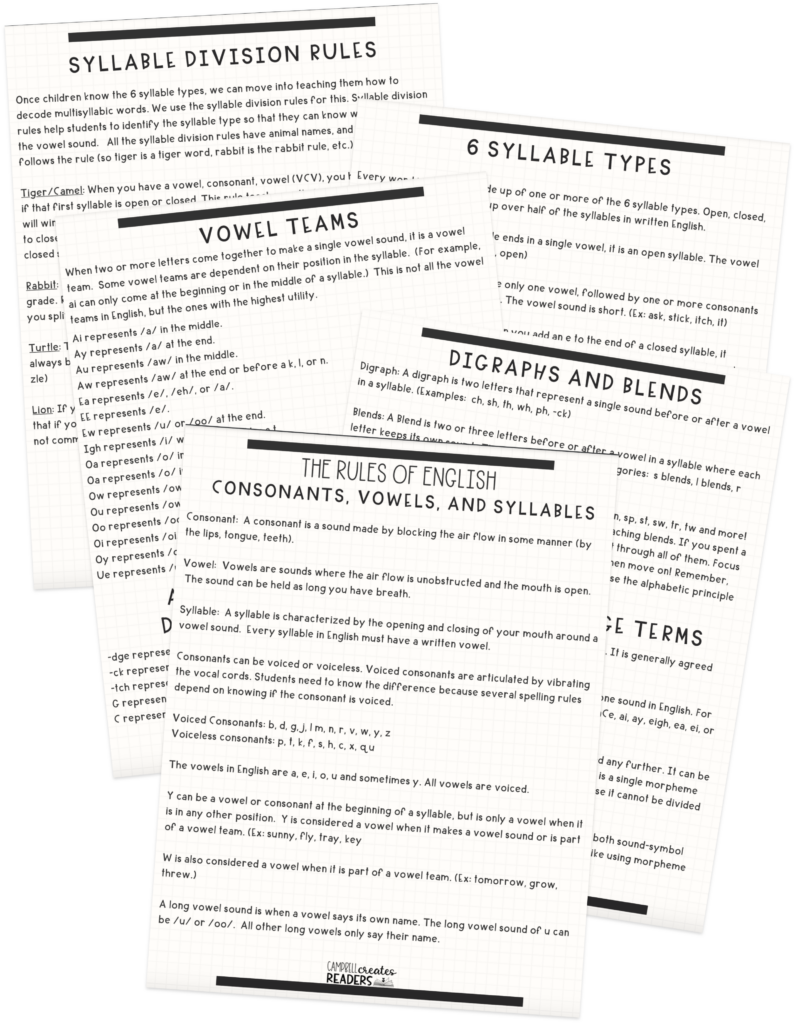
Share This:
I’ll be honest: I’m writing this blog for Instagram. Kinda. There are some questions that I get asked a lot. For the sake of time—or if I’m focused on my daughter, halfway through my third coffee, or juggling twelve open tabs in my brain—my answers aren’t always as thorough as I want them to be.
So, I thought I’d create a blog post with some of the most-asked, most-discussed questions I hear from educators. That way, I can give the thoughtful, nuanced responses I wish I could send each time.
Some of the answers you’ll read today don’t have a strong evidence base behind them—at least, not yet. As far as I know, we just don’t have research on certain things, like when a child should stop using their finger to track print. Other topics, like teaching letter names alongside sounds, do have clear research to guide us.
Wherever possible, I’ll cite evidence. Where I’m relying on my professional experience and the collective wisdom of the field, I’ll be clear about that, too. Let’s dive in.
Decodable texts are NOT the end goal. Our end goal is always to give children the ability to read and understand any text we put in front of them. If we only feed children a diet of controlled texts, they won’t be able to transfer that learning to other texts.
We also need to remember that there’s a difference between the texts we’re asking students to read on their own, and the texts we’re asking students to grapple with during different parts of the day. We’re not using decodable texts for our comprehension instruction. We also aren’t using leveled texts in our small groups for kindergarteners. If we’re practicing basic phonics and decoding, we use decodable texts in our small groups. But we are always using authentic, rich texts during comprehension lessons (whether students are reading aloud or the teacher is).
A decodable text is intended to give children the practice they need to become proficient in specific skills. Because of this, decodable texts tend to focus on one phonics pattern, such as the digraph ch- or the different ways to spell long a. While other skills may be included, these texts are contrived and are not “natural” texts. The sentence structure, vocabulary, and storyline are dictated by a finite number of phonics patterns. At some point, we must start asking our students to read those texts that aren’t contrived. But when?
I don’t know of any hard and fast rules. Decodables are a relatively new topic in the world of research. Instead, I have to use what I know about how children learn to read and my own experiences as a reading specialist to determine when we move away from decodables.

There’s a few things I want my children to be able to do before we stop using decodables.
First, they should have mastered most basic phoneme-grapheme correspondences in single-syllable words. If students have not mastered skills such as digraphs, blends, magic e, r-controlled vowels, and the major vowel teams, they will most likely be unsuccessful trying to read traditional literature.
Next, students should be beginning to read multisyllabic words. Very few books only include single-syllable words. I find that phonics instruction tends to go from decodables to traditional literature, without any real segue between single-syllable and multisyllabic words. Don’t forget to instruct on multisyllabic words just like you do basic phoneme-grapheme correspondences.
Once children know basic orthographic features and are beginning to read multisyllabic words, we can bring in some more traditional texts. I recommend looking at your science and social studies standards, determining a content focus or a theme, and utilizing texts that can help build both background knowledge and vocabulary.
I asked my professor in college this question, and her response was “As soon as children have a firm Concept of Word.” And if you’re sitting there thinking, Wait, what’s Concept of Word?, you’re not alone. Concept of Word (or COW) was a term that originated from the University of Virginia and became a big deal in Virginia schools when PALS was first rolled out around 2000. But outside of the Commonwealth? It’s pretty much crickets. No one else really even knows what it is. So if you’ve never heard of it, don’t worry—you’re not behind. (Also, to my fellow Virginians who spent two decades assessing and teaching COW… are we entitled to compensation for our trauma yet?)
Here’s my take.
There’s no magical age or grade level when children suddenly need to stop using their finger to track words. In fact, there may always be a time and place for finger-pointing—even for adults.
Let me give you a few examples from my own life. If I’m reading a dense research article, especially one about reading science or brain-based instruction, I’ll sometimes find myself using my finger to move through the text slowly, line by line, just to keep track of where I am. Or if I’m following along while someone reads aloud from a PowerPoint in a presentation? Yep, I’m pointing at the screen with my finger to find my place again.
It’s a support strategy—and that’s all it is.

For most kids, this habit fades naturally over time. In my experience, the majority of students stop pointing somewhere between second and third grade. (This isn’t based on research, just my own observations as a reading specialist working with lots of little readers over the years.)
That’s when I start thinking about fluency. The main reason we want students to eventually move away from pointing is because it can slow them down. If using a finger to track print is affecting a student’s pace or phrasing, that’s my cue to step in. I’ll start gently prompting them—“Let’s try that one without your finger this time,” or “Can you read it again just using your eyes?”—always in a way that builds confidence, not pressure.
Bottom line: there’s no hard rule here. Finger-pointing isn’t a reading sin, and it isn’t something we need to correct immediately unless it’s getting in the way. Like most things in literacy, it’s about knowing your students and making decisions based on their individual needs and progress—not on a one-size-fits-all timeline.
This one might surprise you: I don’t believe there’s a hard stop when it comes to children reading out loud (as opposed to reading silently). In fact, reading aloud can remain part of a student’s life for much longer than we would think. After all, have you ever had to whisper a line to yourself while you were reading?
In the early years, reading aloud is a crucial scaffold. It helps us assess decoding, accuracy, and expression. It also helps students to hear the sounds they are connecting to the print. But as children become more fluent, they often transition to silent reading—and that’s a good thing. It signals automaticity. It shows that they don’t need to read out loud in order to decode or comprehend.
That said, I still ask even my older students to read aloud at times (NOT round robin reading). Here’s why:
If a student resists reading aloud, I don’t force it. I just find another way to listen in—partner reading, having them subvocalize while I look in (basically they’re whisper reading it to themselves, but I can see their mouths moving), or having them read when the rest of the students aren’t there.

Here’s my general rule of thumb: If reading aloud is helping a student—whether for decoding practice, fluency, or confidence—keep it. When it becomes a crutch that slows them down or makes them self-conscious, it’s time to scale it back.
Letter sounds and phonemic awareness are the two biggest indicators of how well children will learn to read in the first two years of school. But that doesn’t mean that we teach letter sounds and forget about the letter names. And yes, I have heard multiple people say to just teach letter sounds, including some pretty popular influencers on social media.
So, what do we do? Do we teach them both? At the same time or separately?
When it comes to teaching letters, we should teach letter names and sounds at the same time. We simply cannot leave out teaching students letter names. According to research, “studies providing letter name instruction as the only alphabet component showed reliable, positive impacts on children’s letter sound learning”(Piasta and Wanger, 2010, p.12). So even when ONLY letter names were taught, children were able to learn letter sounds. Why? Because so many of the sounds are embedded in the letter name–think t, b, j, k, p, etc.
A rote knowledge of letter names is required to function in this world. When someone asks me how to spell my name, I don’t start sounding it out for them. I tell them the letters.

That’s why it’s not an either/or—it’s a both/and. Teaching letter names alongside sounds gives students multiple entry points for learning and using the alphabet. It supports phonics, builds reading readiness, and reflects the way letters are used in real life. So yes, teach the sound. But teach the name, too. Our kids need both. And the research is there to support us.
Let’s clear something up right away: we don’t currently have strong research that definitively says we should teach syllable types—or that we shouldn’t. The evidence just isn’t there either way.
But here’s where I land: even without a huge stack of studies, I believe teaching syllable types is one of the most practical, powerful tools we can give our students. Why? Because every single word in the English language can be broken down into one of six syllable types: closed, open, magic E (also called vowel-consonant-E), vowel team, R-controlled, and consonant-le.
And when students know these six types? They can start to unlock the code of English. It can help break open the written word for our students.
Teaching syllable types gives kids a framework—a way to look at a word and figure out what the vowel is likely to do. And let’s be honest, when it comes to reading multisyllabic words, it’s the vowels that trip kids up the most. Is that A saying /ă/ like in apple? Is it part of a vowel team, like AI in rain? Is it working with an R, like in car?
When we teach syllable types, we’re helping students notice vowels more strategically. They start to recognize patterns. They begin to anticipate what a vowel is likely to say based on what surrounds it. That’s a game-changer—not just for reading, but for spelling and fluency too.

I see syllable types as a bridge. They take students from reading single-syllable words (where a lot of early phonics instruction stops) into decoding longer, more complex words. We’re not asking kids to memorize every word in English—we’re giving them tools to figure words out for themselves.
So while the research may not yet tell us yes or no, my experience as a reading specialist tells me this: teaching syllable types gives kids power. And I’ll take empowering my students with a systematic way to approach words over leaving them to guess every time.
Learning about phonemic awareness felt like uncovering the missing piece for so many of my students. It suddenly made so much sense—how could these children possibly read and spell if they couldn’t even hear the sounds within a word? Realizing this was a turning point for me and signaled a fundamental shift in my instruction.
So what exactly is phonemic awareness?
Phonemic awareness is, by definition, an oral skill. It’s the ability to hear, identify, and manipulate individual phonemes—the smallest units of sound in language. These skills include blending sounds together to form a word, segmenting a word into individual sounds, deleting or substituting one sound for another—all without ever seeing the word in print. It’s all done through listening.
I can say with complete sincerity that David Kilpatrick’s work in Equipped for Reading Success changed my teaching for the better. After devouring his book, I began embedding phonemic awareness instruction into every lesson. I administered the PAST to each student and began to layer phonemic awareness work intentionally throughout our day.

Then I read the article They Say You Can Do Phonemic Awareness Instruction in the Dark, but Should You? A Critical Evaluation of the Trend Toward Advanced Phonemic Awareness Training. It discusses issues like teaching advanced phonemic awareness skills like substituting and deleting. It also discusses whether or not we should include letters in our phonemic awareness instruction. With the rise of so many oral-only phonemic awareness curriculum, it was an article that shook my understandings of phonemic awareness instruction.
Without getting into too much detail (you can read more about the hot-button issues in phonemic awareness here), this is what’s important to understand: while phonemic awareness is oral-only, we now know that instruction is even more effective when we connect it to print.
While PA is inherently oral, research indicates that incorporating letters into PA instruction can significantly enhance its effectiveness. The National Reading Panel (2000) found that teaching children to manipulate phonemes using letters produced larger effects on reading and spelling performance than instruction without letters . Specifically, the effect size for reading outcomes was nearly twice as large when letters were included (d = 0.67) compared to when they were not (d = 0.38). I repeat, reading outcomes had twice the effect size when letters were added. That is solid proof that letters should be incorporated into phonemic awareness instruction.
What does that look like in practice?
It might start with orally segmenting a word like cat into /k/ /a/ /t/. That’s a foundational phonemic awareness skill. But then we pull out letter tiles and connect each sound to a letter. Now we’re bridging phonemic awareness and phonics—and that’s where the magic really happens.
So when people ask me, “Is phonemic awareness oral only?” I say yes… and. Yes, it’s an auditory skill. But the most effective instruction doesn’t stop there. It blends the power of oral sound work with the structure and support of written language. That’s how we help students not only hear the sounds—but map them to print, and own them for life.
If there’s one thread running through all these questions, it’s this: the answer is almost never a one-size-fits-all rule. So much of reading instruction—especially the kind that’s responsive, nuanced, and actually works—depends on context, on individual students, and on our ability to blend research with professional judgment.
Yes, we rely on evidence where it exists. But where the research is still catching up, we lean on our experience, our observations, and what we know deep down to be true about how kids learn. Teaching reading isn’t about checking boxes—it’s about making thoughtful decisions, grounded in science and in practice.
So as you leave this post, here’s what I hope sticks with you: Trust the research, but also trust yourself. The questions we’re asking matter—and even if the answers aren’t always simple, the fact that we’re asking them means we’re on the right path.
Clemens, N., Solari, E., Kearns, D. M., Fien, H., Nelson, N. J., Stelega, M., Burns, M., St. Martin, K. & Hoeft, F. (2021, December 14). PsyArXiv
Kilpatrick, David A. Equipped for Reading Success: A Comprehensive, Step-by-Step Program for Developing Phonemic Awareness and Fluent Word Recognition. Casey & Kirsch Publishers, 2016.
National Reading Panel. Teaching Children to Read: An Evidence-Based Assessment of the Scientific Research Literature on Reading and Its Implications for Reading Instruction. National Institute of Child Health and Human Development, 2000.
Piasta, S. B., & Wagner, R. K. (2010). Developing early literacy skills: A meta-analysis of alphabet learning and instruction. Reading Research Quarterly, 45(1), 8–38. https://doi.org/10.1598/RRQ.45.1.2
Share This:

Savannah Campbell is a K-5 reading specialist. She has taught her entire 12-year teaching career at the school she went to as a child. She holds two master’s degrees in education from the College of William and Mary. Savannah is both Orton-Gillingham and LETRS trained. Her greatest hope in life is to allow all children to live the life they want by helping them to become literate individuals.

Savannah Campbell is a K-5 reading specialist. She has taught her entire 12-year teaching career at the school she went to as a child. She holds two master’s degrees in education from the College of William and Mary. Savannah is both Orton-Gillingham and LETRS trained. Her greatest hope in life is to allow all children to live the life they want by helping them to become literate individuals.
Feeling overwhelmed with all the terminology out there? Want to know the key terms all teachers need to teach phonics? In this FREE Rules of English cheat sheet, you get a 5 page pdf that takes you through the most important terms for understanding English—you’ll learn about digraphs, blends, syllable types, syllable divisions, and move. Grab today and take the stress out of your phonics prep!
